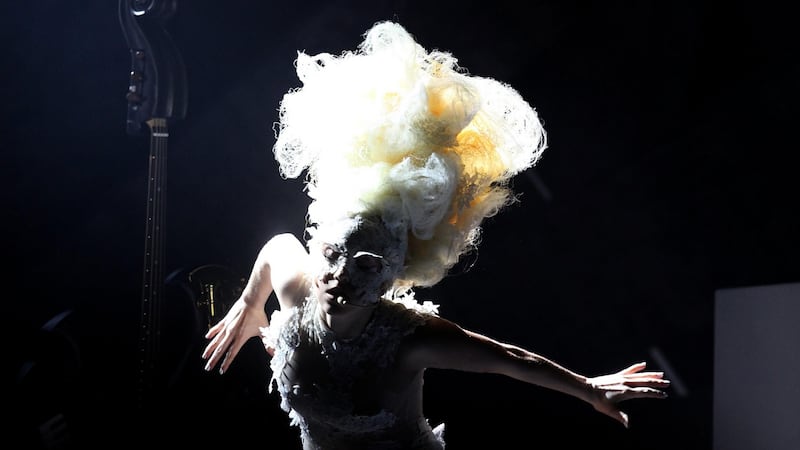The pop banger is a sacred thing. Not to be confused with a bop, which is a mid-tempo song that puts a pep in your step, a pop banger has a chorus so big that the veins in your neck pop, a key change so sharp that the hairs on the back of your neck stand and a tempo so intense that if you stop dancing . . . you will die. However, the modern pop song is slower, the choruses less flamboyant and the key change more modest, meaning that in 2019, the pop banger is in decline.
While Norwegian pop star Sigrid, Canadian singer Carly Rae Jepsen and the creative genius Janelle Monáe continue to fly the flag for earth-shattering choruses on songs like Sucker Punch, Party For One and Make Me Feel, we are living in a post-chorus world. Where we once had the roar of Lady Gaga's Bad Romance or the thud of Kesha's TiK ToK in the banger-filled year of 2009, the big hits of 2018 use a vocal-led bridge to build up to the anti-climax – or total absence – of a chorus, as Dua Lipa and Calvin Harris's number one summer single One Kiss demonstrates.
And where we once thrashed our bodies around until the lights in the club went up, our dance moves have slowed down to a sway to accommodate the mellowed-out pace of this bop-filled world.
In 2011, back when bangers were at their peak, two masters students from Rutgers University deconstructed 50 years of Billboard Hot 100 number one singles to find the formula for a hit single. In Shaun Ellis and Tom Engelhardt's Visualising a Hit presentation, they calculated that if you wanted a number one single in 2011, the optimal tempo was 119.80 beats per minute. Using 119.80 BPM as the baseline, we can detect the rise and fall of a pop banger over the past 20 years and it can be broken down into four eras; the Bubblegum Pop Era, the Pop Idol Era, the Amphetamine Pop Era and the Xanax Pop Era.
The upbeat, accessible and fun Bubblegum Pop Era started in 1998 with the release of Britney Spears's …Baby One More Time (98 BPM). Spears's debut single was produced and written by Swedish pop Svengali Max Martin and its success helped propel the careers of N*Sync, Pink and Christina Aguilera. With choreographed dance routines, explosive key changes and catchy choruses, these artists and their songs redefined the charts and as these teen stars grew up, their sound became more mature, taking us from kids' birthday parties to the club and increasing the need for bangers to dance to all night long.
Pop Idol Era
With the Bubblegum Pop Era proving not to be a fluke, 2001 saw the launch of the TV series Popstars and Pop Idol, with American Idol and Popstars: The Rivals following in 2002. The most notable stars to come from this time – the Pop Idol Era – are 2001 American Idol winner Kelly Clarkson and the British and Irish group Girls Aloud from Popstars: The Rivals, who won the series by beating boyband One True Voice to the 2002 Christmas number one spot with the pneumatic banger that is Sound of the Underground (164 BPM).
There was a bigger appetite for pop stars and pop music in the early noughties, so while remaining a member of Destiny's Child, Beyoncé began to test the waters as a solo act. Even though the R&B trio were having huge success with their 2001 singles Independent Women Part 1 and Survivor, which has a whopping BPM of 161, Beyoncé broke out the horns for her debut 2002 single Work It Out (174 BPM),before officially launching her solo career in 2003 with the career-defining and decadent Crazy In Love (99 BPM).
With the brassy Crazy In Love, the standard of the pop banger was raised to a more outlandish standard and it was about to be set even higher with the release of Clarkson's 2004 single Since U Been Gone (131 BPM). With its sky-scraping vocals and breathtaking build, this rock-pop anthem is a key song in the pop banger timeline because it's the first song that sees Max Martin and producer Dr Luke join forces as a hit-making team. Martin and Dr Luke would be responsible for writing and producing some of the biggest songs for the next era of pop – the indulgent and ferocious Amphetamine Pop Era. This era, which peaked between the years 2008 and 2012, found its foundations in stars like Rihanna and Girls Aloud.
At the hands of the producer Xenomania, Girls Aloud's music is unconventional, experimental and bloody fantastic. Between 2003 and 2007, their singles No Good Advice (148 BPM), Biology (146 BPM) and Sexy! No No No… (134 BPM) are frantic and mental, toying around with jolting rhythms and chopped tempos; prepping us for even more experimental pop music from one Lady Gaga, trashier pop from Kesha and more tongue-in-cheek pop from Katy Perry.
Thrillingly manic
The songs are now faster, the delivery even more grandiose, the choruses thrillingly manic and the production more lustrous. In this four-year period, Martin and Dr Luke worked on about 30 songs together, churning out bangers like Kesha's Blow, Spears's Till The World Ends (where Kesha is also credited as a songwriter) and Perry's I Kissed a Girl, Teenage Dream and Hot N' Cold. The other big hitters of these years were heavily influenced by dance music, with Harris working with Rihanna on We Found Love (128 BPM) and David Guetta collaborating with Sia on Titanium (126 BPM), but our singers were still the glittering stars of the show.
Rihanna's and Lady Gaga's careers reached stratospheric levels during the Amphetamine Pop Era, ramping up the BPM of the average chart hit. From her 2008 debut Just Dance to 2011's Marry the Night, Lady Gaga released 14 solo singles – six of them number one hits – and the average BPM of a Gaga song was 125. Rihanna barely had a moment's rest, rolling out albums in 2009, 2010, 2011 and 2012 that were chock-a-block with dizzying bangers like Only Girl (In The World) (126 BPM) and Where Have You Been (128 BPM).
With this adrenaline rush in the charts, even the then girl-next-door country singer Taylor Swift caught the banger bug in 2012. Working with Martin on singles 22, We Are Never Ever Getting Back Together and I Knew You Were Trouble, a song that came with an unexpected dubstep drop, these songs changed the direction of her career completely.
The dance floor was a pretty sweaty place to be in 2012. Pop fans were left breathless and our pop stars . . . Well, the hits and the bangers were released at an unsustainable rate so by the end of 2013, our stars either took a break from music like Rihanna, faced critical backlash like Gaga or, like Beyoncé, found a way to reinvent their sound in next era of music; the Xanax Era.
With the increased popularity of Lana Del Rey in 2012, whose music is the musical equivalent of morphine on a drip, and the understated rap stylings of Drake in 2013, the charts were about to have a makeover and Beyoncé’s 2013 self-titled album helped changed the mood.
Ditching the hectic pop sound she practised on her 2011 album 4, she embraces disjointed sounds on Beyoncé, with tripping beats, dark melodies and a hip-hop sheen. Instead of choruses and key changes coming in like a whirlwind, the Xanax Pop Era draws heavily from the hip-hop world and showcases the work of producers that are now credited as lead artists, like Harris, Major Lazer and The Chainsmokers. And while we still get the occasional blast of a banger, like Mark Ronson's and Bruno Mars's 2014 infectious hit Uptown Funk or Beyoncé 2016 genre-crushing political banger Formation, this era is defined by restraint and minimalism and we are left waiting for the drop that never comes.
Slowing down
Choruses are the running engine of a banger but in 2015, the hollowed-out chorus entered the charts. Pop brat Justin Bieber and underrated pop princess Selena Gomez – and, coincidentally, an on-again, off-again celebrity couple – experienced career resurgences in 2015 as they ditched their teen-star status by releasing more mature music.
Bieber's single Sorry (100 BPM), showcases the skills of producers Skrillex and BloodPop instead of Bieber's, and Gomez's Hands to Myself (111 BPM), co-produced by Martin, uses a big bridge to build up to a chorus that relies on padded synths and cooing vocals from Gomez. After decades of big choruses from Spears, Lady Gaga et al, these songs do the unexpected and change the gears of the vocal pop chorus from loud and brashy to almost non-existent. If 119.80 BPM was the optimal speed for a charting song in 2011, then Yakov Vorobyev, the creator of the Mixed in Key DJ app, has confirmed that things have become even slower. Studying the most-streamed Spotify tracks of 2012 and 2017, he calculated that the average BPM of a chart song is now stewing at 90.5 BPM. Reducing the chorus and the speed is the unexpected twist that makes these songs different.

As we get to know our artists a little bit better through social media, it's likely that they are making music that's truer to their broadcasted life experiences. Two of the biggest pop albums released this year, Ariana Grande's Sweetener and Robyn's Honey, have a distinct lack of uptempo bangers on them, as both artists delve into the personal.
For Grande, the tragedies of the 2017 Manchester Arena bombings and the death of her ex-boyfriend Mac Miller, have seen her find solace in making music. Songs like Breathin' (100 BPM), Get Well Soon (100 BPM) and No Tears Left To Cry (122 BPM) are bops rather than bangers and they therapeutically take on issues like anxiety, loss and recovery. Thank U, Next (107 BPM), the current number one song in Ireland, directly references the death of Miller and details the hard lessons that the last few years have taught her. "I've learned from the pain, I turned out amazing," she sings but without using the full capacity of her soaring voice.
Robyn's Honey is the calm after the storm of 2010's Body Talk, which houses the ultimate sad bangers Call Your Girlfriend and Dancing On My Own. Using spaced-out electro and trance beats, Honey is a tonic for despair and heartache. Between Grande and Robyn, the lyrics are considered, the tempo is levelled and the overall vibe is soothing and reassuring, rather than fist-pumping and energising. But perhaps, a little more crucially, the pop world is responding to the MeToo movement. In 2014, Lady Gaga revealed on The Howard Stern Show that she was raped by a music producer when she was 19 years old and, earlier this year, English pop laureate Lily Allen disclosed in an interview with the Guardian – and detailed even further in her memoir My Thoughts Exactly – that she was sexually assaulted by a record industry executive.
Introspective music
On Allen's 2018 Mercury-nominated album Shame and Gaga's 2016 album Joanne, they create introspective music that details their personal hardships, using slower melodies to reflect the mood. Their experiences are, unfortunately, not unique and with the increasing awareness of mistreatment in the music and film industry, it's very possible that artists now have the support to distance themselves from abusers, choosing to work with different producers or songwriters, and fans are choosing to not listen to music created by these same people anymore.
While Martin continued his hit-making streak – co-producing Swift's 1989 and Reputation albums and co-producing Ariana Grande's 2016 album Dangerous Woman, which boasts the single Into You, one of the biggest bangers of the last three years – Dr Luke's career took a downturn.
Kesha, who is signed to Dr Luke’s Kemosabe Records label, sought to break her contract with the producer in 2014 with allegations of sexual, physical, verbal and emotional abuse. The case was dismissed in 2016 but artists like Swift, Clarkson, Miley Cyrus, Adele and Lady Gaga vocalised their support for Kesha, with Swift donating $250,000 to Kesha for “any of her financial needs” and Adele dedicating her 2016 Brit Award for Best Female Solo Artist to the singer.
Despite the court's ruling, any artists that have worked with him, like German singer Kim Petras, whose 2018, Dr Luke-produced, single Heart to Break is a certified banger, are criticised by fans for doing so. Much like the film industry, pop is currently in a state of PTSD and as artists are carefully unpacking their experiences through music, fans are faced with the moral dilemma of separating art they like from the artists they don't like.
To compare the biggest songs of today to the biggest songs of 10 years ago would be like comparing camomile tea to a Jaegerbomb and while this doesn't mean that the quality of music has dropped, the formula has simply changed. The biggest-selling songs of 2018 were Drake's God's Plan (77 BPM) and Nice for What (93 BPM), Rudimental's These Days (99 BPM) and Dua Lipa and Harris's One Kiss (124 BPM), placing chorus-less bops and low-slung hip-hop where bangers used to reign. But as cyclical as music is, trends tire and we will need something different to wake us up and get our blood pumping again. The bop will bow down and the banger will rise again; harder, faster, louder, weirder and better than ever.
The best pop bangers of the last 20 years
Conor Behan, pop expert, DJ and broadcaster
When it comes to pop bangers, Britney has lots. But her debut single …Baby One More Time still feels like a defining moment for her and for pop. Everything about the song gels: the unmistakable intro, the husky vocals and that bold unstoppable chorus. It's a song that feels utterly of its moment but hasn't dated at all. A gem.
Jenn Gannon, pop defender and music journalist
Lady Gaga's Bad Romance is full of sexy drama and chaos. It acts as Gaga's pop national anthem, her calling card. A slice of cold-steel brilliance, it slashes through the heart as her smokey vocals swirl about asking for "revenge", cooing some dodgy French and leading us all into a hot-blooded war-like crescendo that is so utterly relentless it leaves you breathless. She is that 'rah-rah' bitch and she wants your love and you are powerless to resist.
Mango, pop appreciator and deadly MC
It's Controlla by Drake. This is probably my favourite Drake record. The album and this song bring back great memories from a year. I love how weird and minimal this dancehall tune can be and still be such a pumper. The Beenie Man sample makes it. Proper smoocher too, which is always nice to have on a dance floor these days.
Laoise, pop creator and pop supporter
Somewhat left of centre, but my favourite pop banger of the last few years has been Janelle Monáe's Make Me Feel. It always inspires me to write, with its Prince influences and whispery vocals coming from all sides – it's impossible not to move along to it. If you're looking for a super-satisfying pop pay-off that never gets old, this song does just that.



















